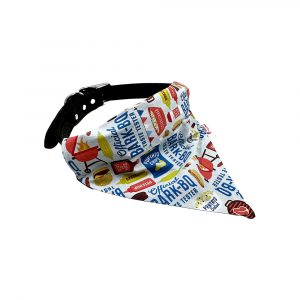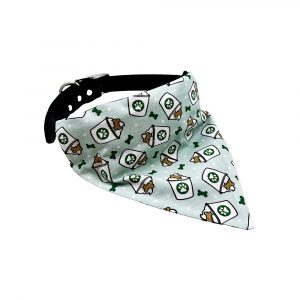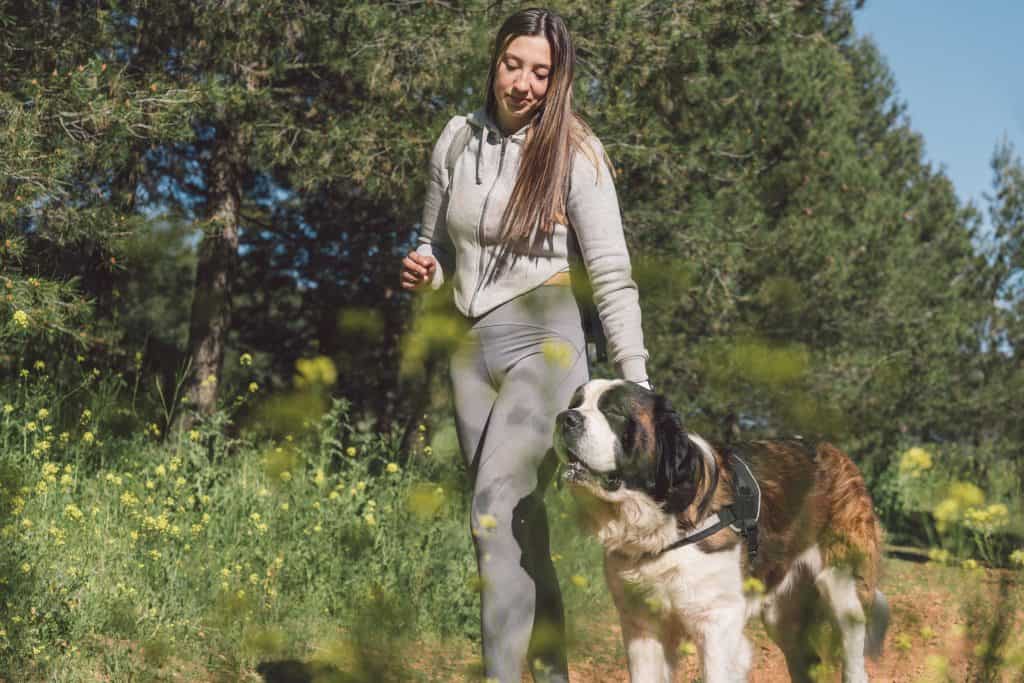Editor’s Note: This article includes expert insights from licensed veterinary professionals and references peer-reviewed veterinary sources. However, every dog is unique. Always consult your veterinarian for advice tailored to your individual pet’s needs — and that’s part of what makes them so special.
Saint Bernards, often called the “gentle giants” of the dog world, are beloved for their calm behaviour and impressive size. Originally bred in the Swiss Alps to assist in mountain rescues, these dogs combine a rich heritage with a friendly, patient temperament that makes them excellent family companions. Understanding their unique traits, needs, and care requirements can help ensure your 세인트 버나드 thrives as a healthy, well-adjusted member of your household.
Some of our latest products...
-
패턴
Bark-BQ Taste Tester Dog Bandana
$ 8.57~$ 11.43가격 범위: $ 8.57~$ 11.43 USD 옵션 선택 이 제품에는 여러 가지 변형이 있습니다. 옵션은 제품 페이지에서 선택할 수 있습니다. -
패턴
Dog Dad Life Dog Bandana
$ 8.57~$ 11.43가격 범위: $ 8.57~$ 11.43 USD 옵션 선택 이 제품에는 여러 가지 변형이 있습니다. 옵션은 제품 페이지에서 선택할 수 있습니다. -
패턴
Puppyccino Delight Dog Bandana
$ 8.57~$ 11.43가격 범위: $ 8.57~$ 11.43 USD 옵션 선택 이 제품에는 여러 가지 변형이 있습니다. 옵션은 제품 페이지에서 선택할 수 있습니다. -
팀 정신
Winnipeg Blue Bombers Dog Bandana
$ 12.85~$ 15.71가격 범위: $ 12.85~$ 15.71 USD 옵션 선택 이 제품에는 여러 가지 변형이 있습니다. 옵션은 제품 페이지에서 선택할 수 있습니다.
When people think of Saint Bernards, the image that often comes to mind is that of a massive, drooling, gentle giant lounging contentedly beside its family. While the “gentle giant” reputation is certainly well-deserved, owning and raising a Saint Bernard comes with its own set of challenges and misconceptions that potential owners should understand before welcoming one into their homes.
Understanding the Saint Bernard Temperament
Saint Bernards are typically calm, gentle, and affectionate dogs. According to the American Kennel Club (AKC), they are known for their loyalty, patience, and kindness, particularly with children, which makes them exceptional family pets. However, given their large physique, owners often face specific temperament challenges tied to size and strength.
Ashley Bankowski, a Licensed Veterinary Technician at Birdneck Animal Hospital, explains:
“One of the most common temperament challenges I see in Saint Bernards is that they don’t always realize just how big they are. They’re usually sweet-natured dogs, but their sheer size and strength can make them overwhelming if they haven’t been taught good manners early on.”
Shannon Griffin, Owner of Hound Therapy LLC, adds:
“One of the most common temperament challenges I see with Saint Bernards is their natural stubborn streak. These dogs are highly intelligent, but their independent nature often shows up as selective listening, particularly with recall and leash manners. This can become a real issue given their size and strength.”
She recommends training early and consistently:
“Short, engaging sessions and calm, patient leadership go a long way in ensuring they grow into well-mannered adults. Setting boundaries when they are young is especially important—what seems cute in a 20-pound puppy isn’t so manageable when that same behavior comes from a 150-pound dog.”
Saint Bernards and Family Integration
Due to their protective yet gentle nature, Saint Bernards make excellent family dogs, especially for homes with children. Their patience and calm demeanour help prevent accidental injuries, but supervision is essential because a 120-pound adult Saint Bernard can unintentionally knock over small children. Gradual and positive introductions to all family members help the dog adjust comfortably.
Socialization and Relations with Other Pets
Saint Bernards generally coexist well with other pets, especially if socialized early. Their temperament is seldom aggressive or dominant. Introducing your Saint Bernard gradually and positively to other animals sets a strong foundation for peaceful cohabitation. Repeated exposure to various environments builds confidence and well-rounded sociability.
Effective Training for Saint Bernards
Saint Bernards are intelligent and eager to please, which can make training easier compared to some large breeds. However, consistency and patience are key, given the stakes involved with their size. Starting training at the puppy stage and reinforcing basic obedience, manners, and leash etiquette encourages good behaviour throughout life.
According to veterinary behaviour studies, ongoing mental stimulation reduces the risk of stubbornness or destructive behaviour in large breeds such as Saint Bernards.
🐾 Expert Insight: Shannon Griffin, Hound Therapy LLC
“The truth is, Saint Bernards are not just big, lovable companions—they’re powerful, sensitive, and intelligent dogs who need thoughtful care and structure. For families ready to meet those needs, the reward is a loyal, affectionate, and truly gentle giant who will enrich their lives in countless ways.”
Exercise and Activity Needs
Despite their reputation for being calm, Saint Bernards require daily exercise to maintain physical and mental health. The ASPCA advises moderate, low-impact activity like walking and gentle play, avoiding strenuous exercise that can stress developing joints.
There’s also a misconception that Saint Bernards are naturally lazy, but that’s far from the full picture.
Griffin explains:
“While they are not as high-energy as breeds like Border Collies, they are far from couch potatoes. They thrive on moderate daily exercise, mental stimulation, and tasks that engage their working-dog heritage.”
She suggests light challenges like carrying a dog backpack on a walk or practicing obedience cues to provide mental stimulation and give them a sense of purpose.
Health Considerations and Lifespan
Saint Bernards generally live 8 to 10 years. Like many large breeds, they are prone to joint problems such as hip and elbow dysplasia, heart conditions, and skin issues.
According to the American Veterinary Medical Association (AVMA), approximately 20–30% of large-breed dogs develop joint problems by middle age, underscoring the importance of early preventative care.
Ashley Bankowski notes:
“Joint support and weight management are absolutely critical for this breed. Carrying too much weight puts a lot of strain on their hips, elbows, and hearts, which can affect both their physical comfort and overall temperament.”
Griffin also highlights two key concerns: joint health and social needs:
“From a well-being perspective, there are two key factors I always emphasize for Saint Bernard owners. First is joint health. Their size puts them at greater risk for hip and elbow problems, so maintaining a healthy weight and providing low-impact exercise is vital. Second is companionship and socialization. These are deeply people-oriented dogs who crave interaction. Left alone for too long, they can develop separation anxiety or clinginess, but consistent socialization helps them stay balanced and confident.”
Adaptability and Climate Sensitivity
Saint Bernards have thick coats originally developed for cold alpine environments, making them poorly suited to hot climates. Overheating can impact their behaviour and health negatively. Providing a cool, well-ventilated living space and avoiding outdoor exercise during warm weather are essential.
According to the AKC, Saint Bernards thrive best in cooler temperatures but can adapt to a variety of living environments when their needs are met.
Summary
Saint Bernards blend strength and affection in a unique way that few other breeds match. With the right training, exercise, socialization, and health care, these gentle giants can flourish as beloved family members.
“The truth is, Saint Bernards are not just big, lovable companions—they’re powerful, sensitive, and intelligent dogs who need thoughtful care and structure,” says Griffin. “For families ready to meet those needs, the reward is a loyal, affectionate, and truly gentle giant who will enrich their lives in countless ways.”
Frequently Aasked Questions
Q1: Are Saint Bernards good with children?
Yes, Saint Bernards are generally very gentle and patient with children. However, due to their large size, interactions should always be supervised to ensure safety (AKC).
Q2: How much exercise does a Saint Bernard need?
A daily walk and some low-impact playtime usually suffice to keep a Saint Bernard healthy. Avoid high-impact activities to protect their joints (ASPCA).
Q3: Are Saint Bernards easy to train?
Yes, they are intelligent and eager to please but require consistent, patient training starting from puppyhood to manage their size and strength effectively (Bankowski, Griffin).
Q4: Can Saint Bernards live comfortably in hot climates?
Saint Bernards have thick coats suited to cooler climates. In warm areas, they need a cool, shaded space and exercise should be limited during hot times to prevent overheating (AKC).
Q5: Do Saint Bernards get along well with other pets?
Generally, yes. Socializing Saint Bernards from a young age with other animals promotes positive relationships. They tend to be non-aggressive and tolerant (Bankowski).







